Sir John Monash, Personal Files Book 16, 3 September - 9 October 1917, Part 18
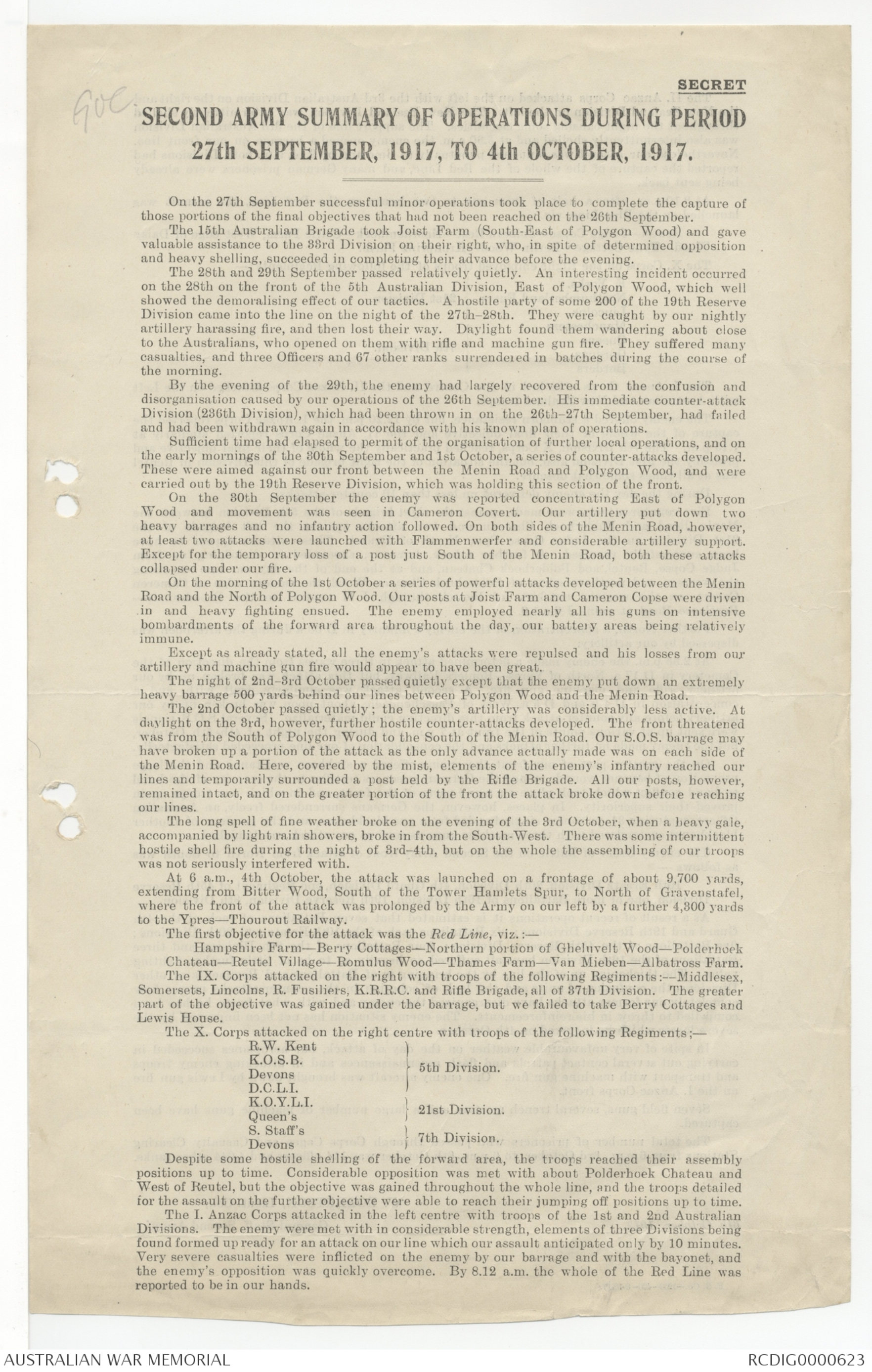
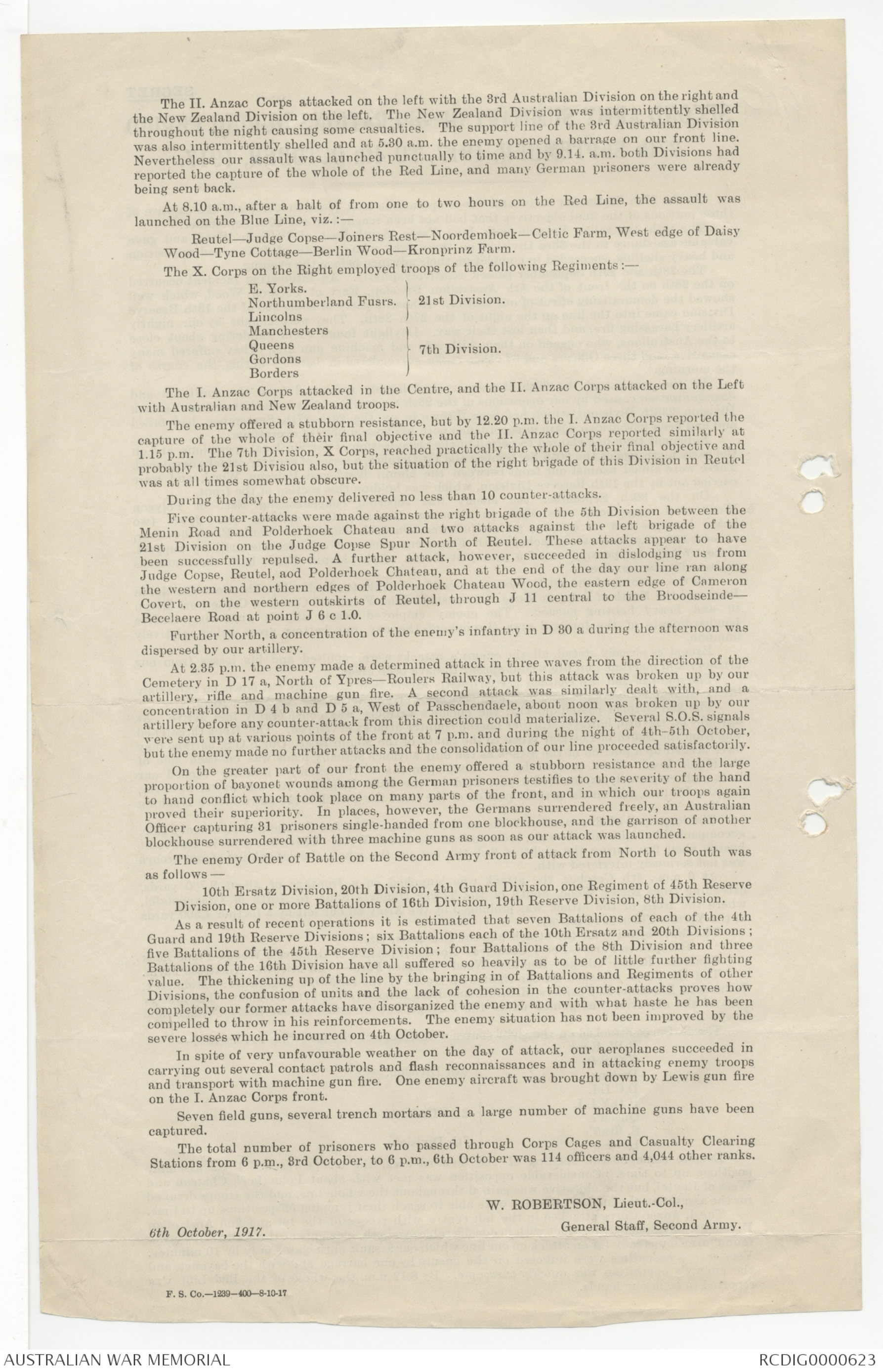
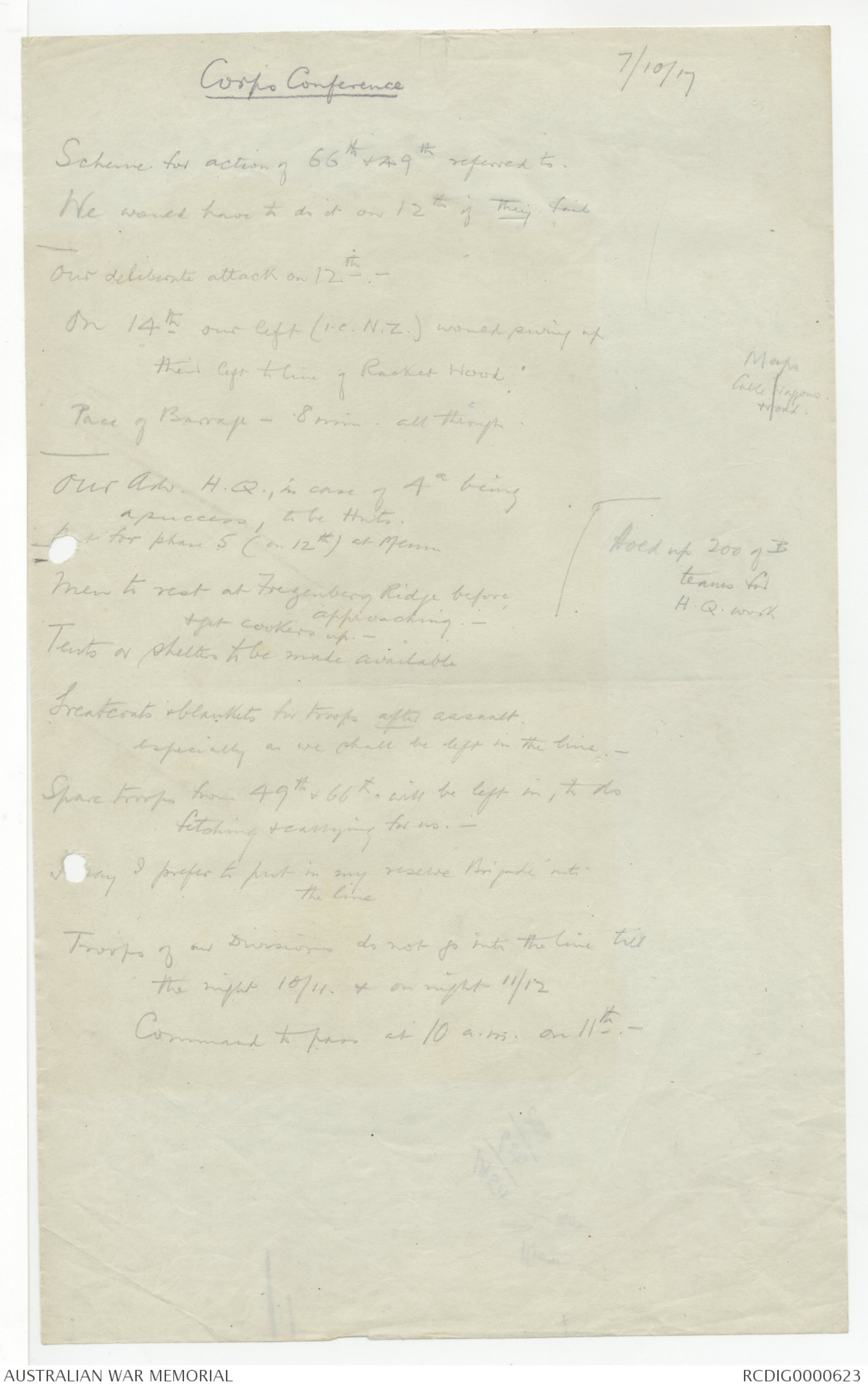
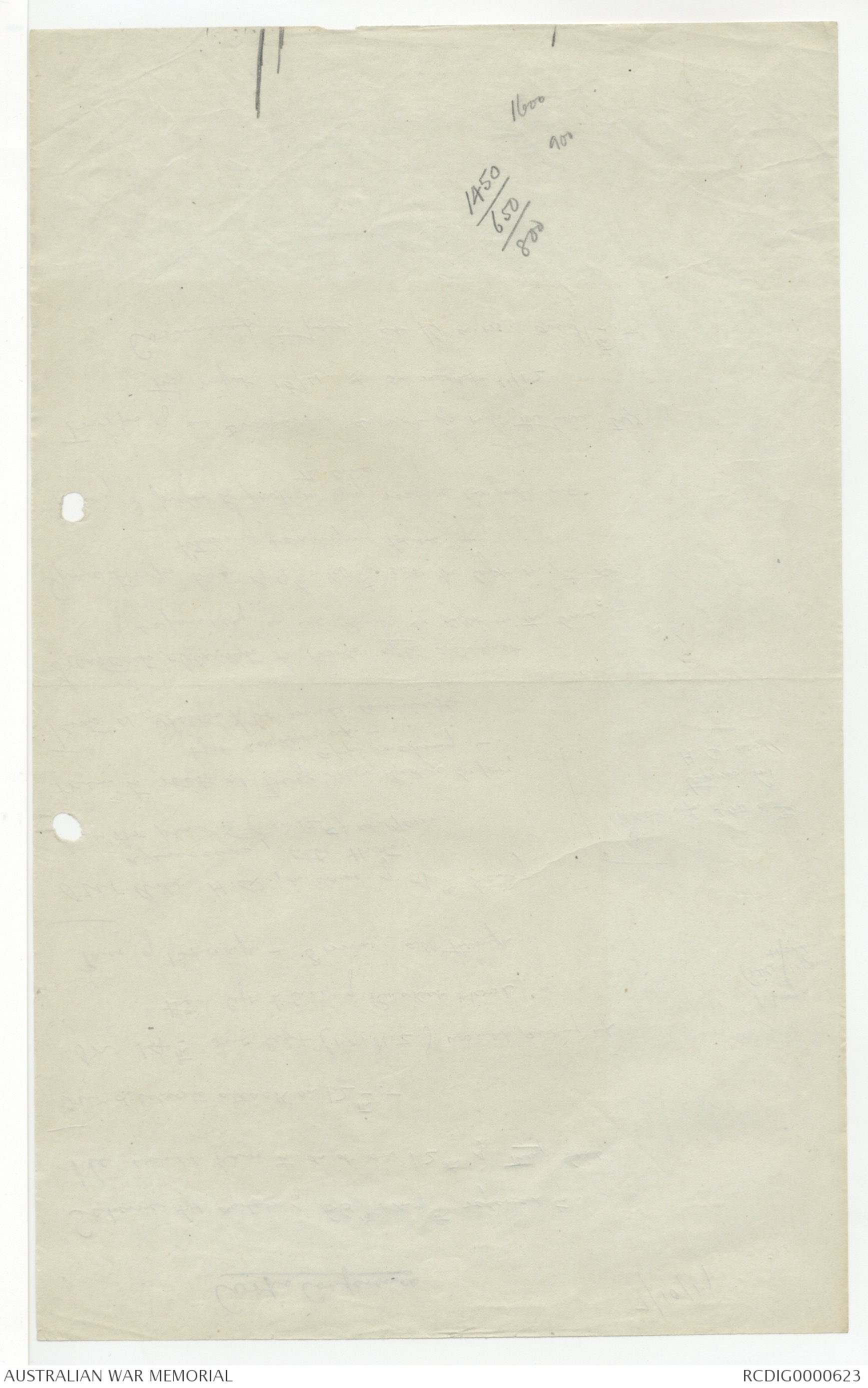
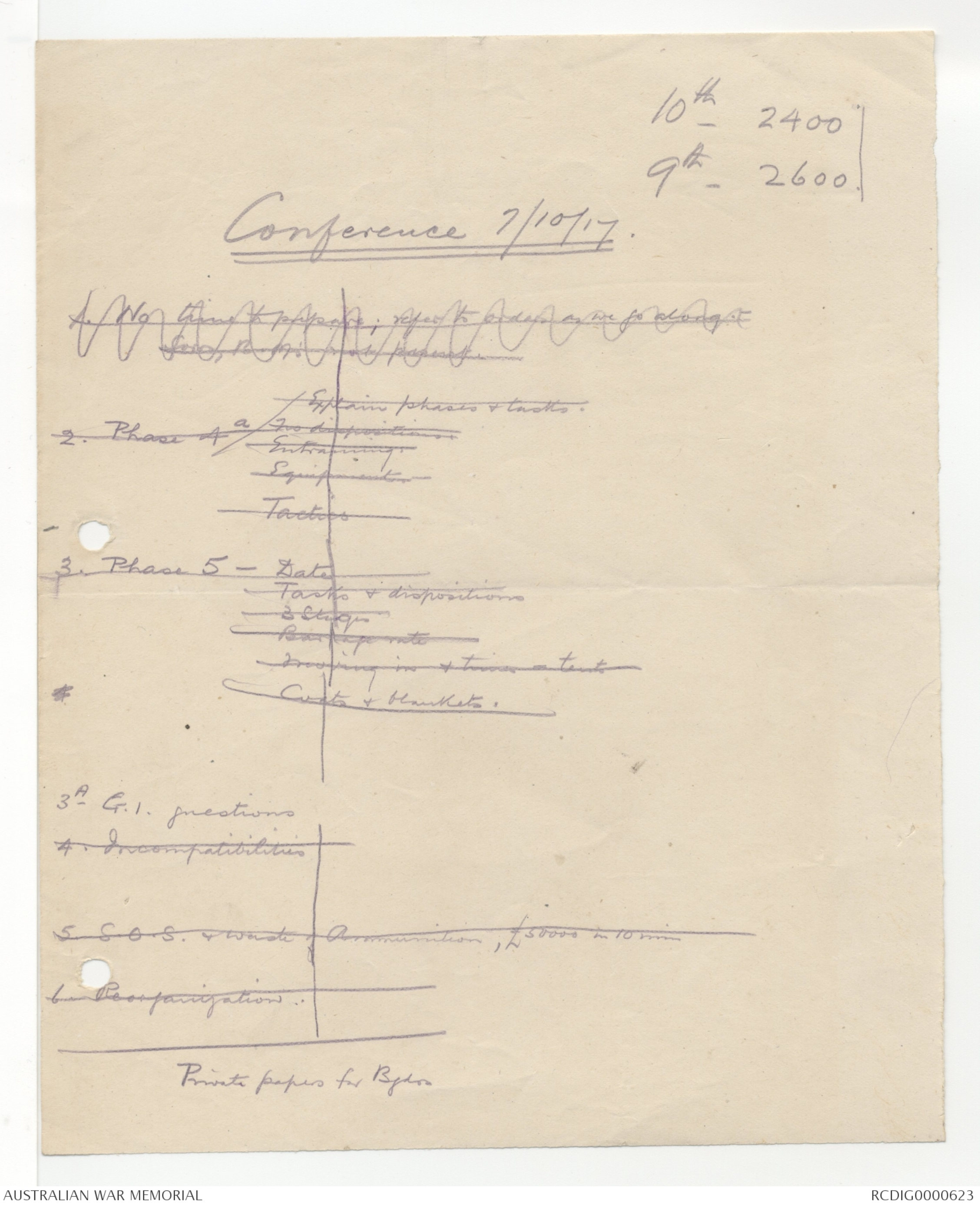
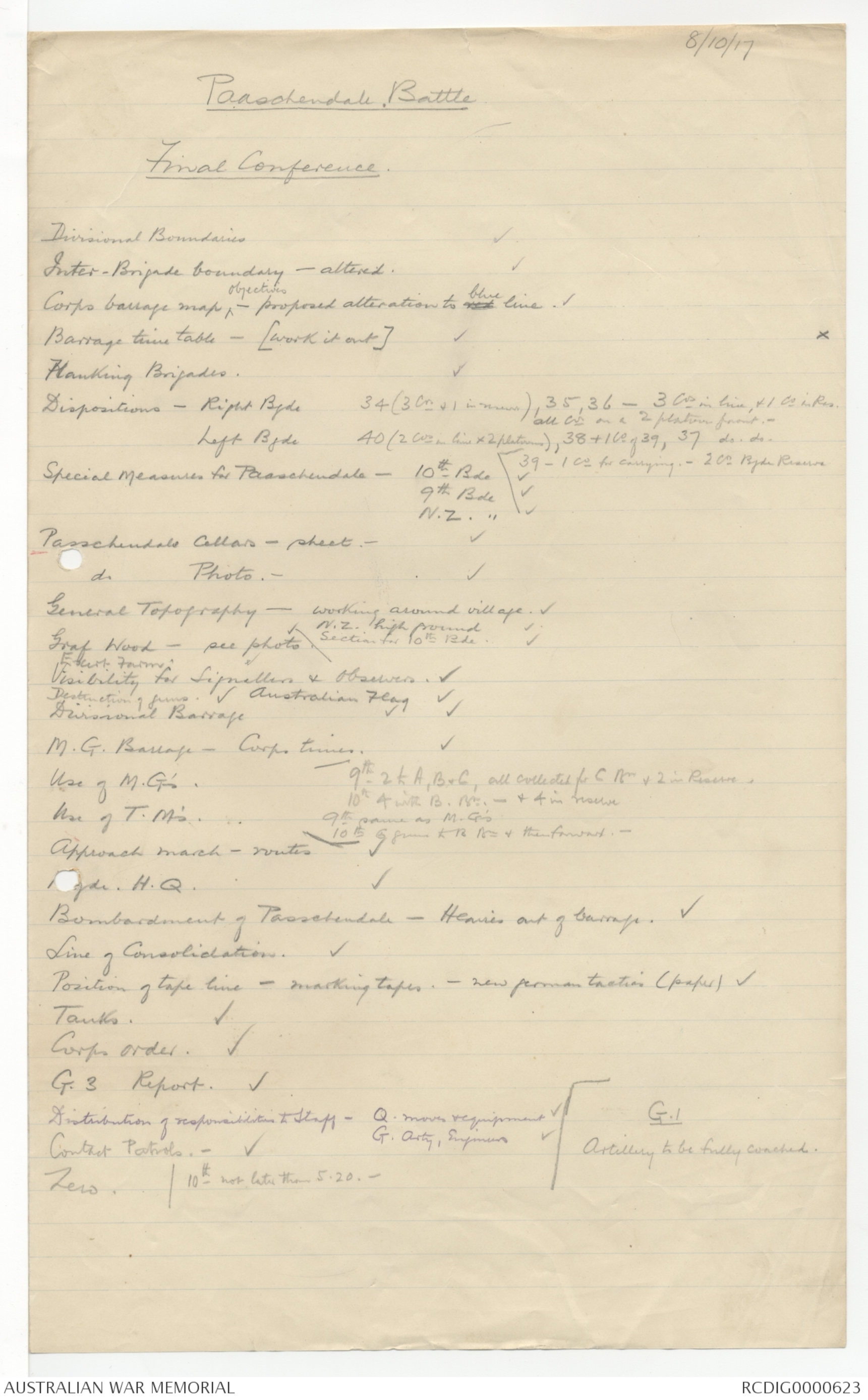
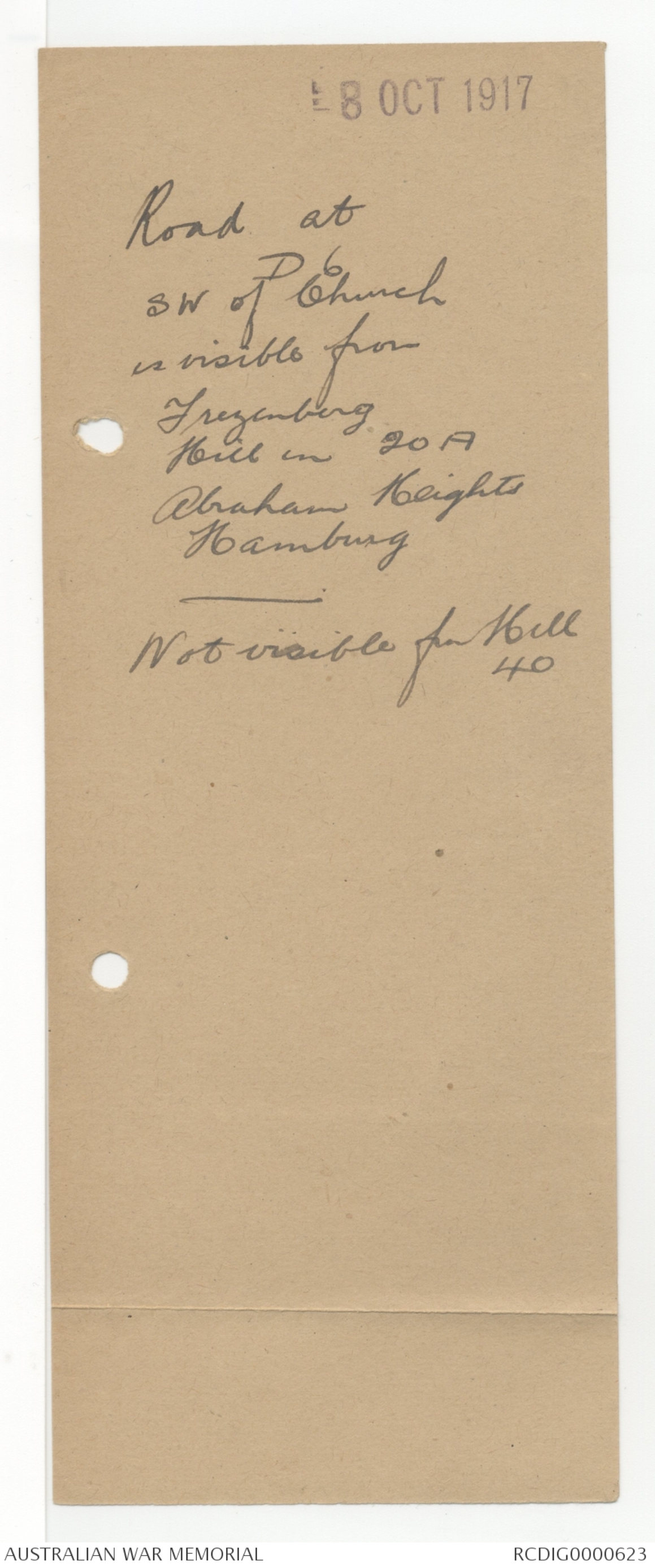
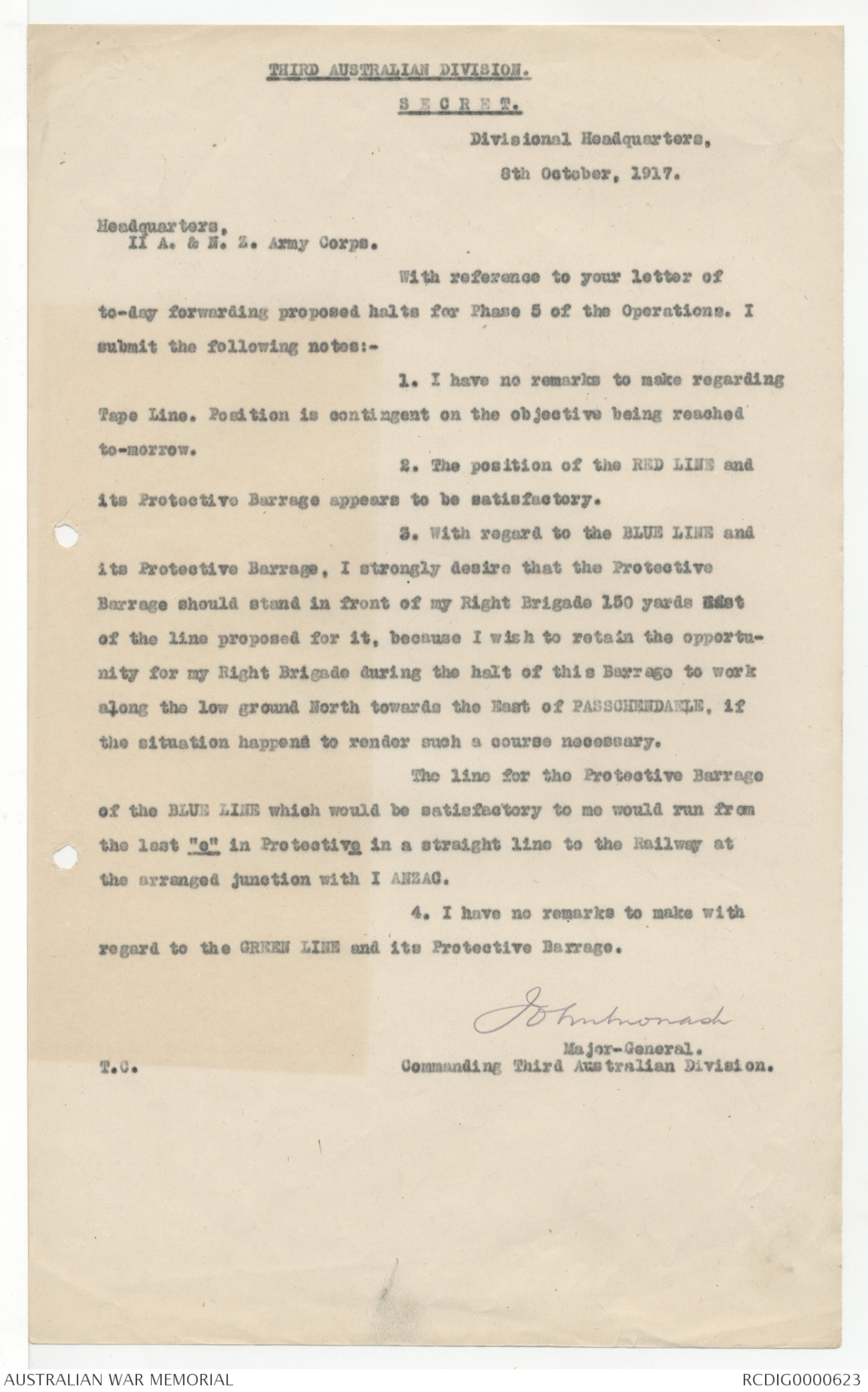
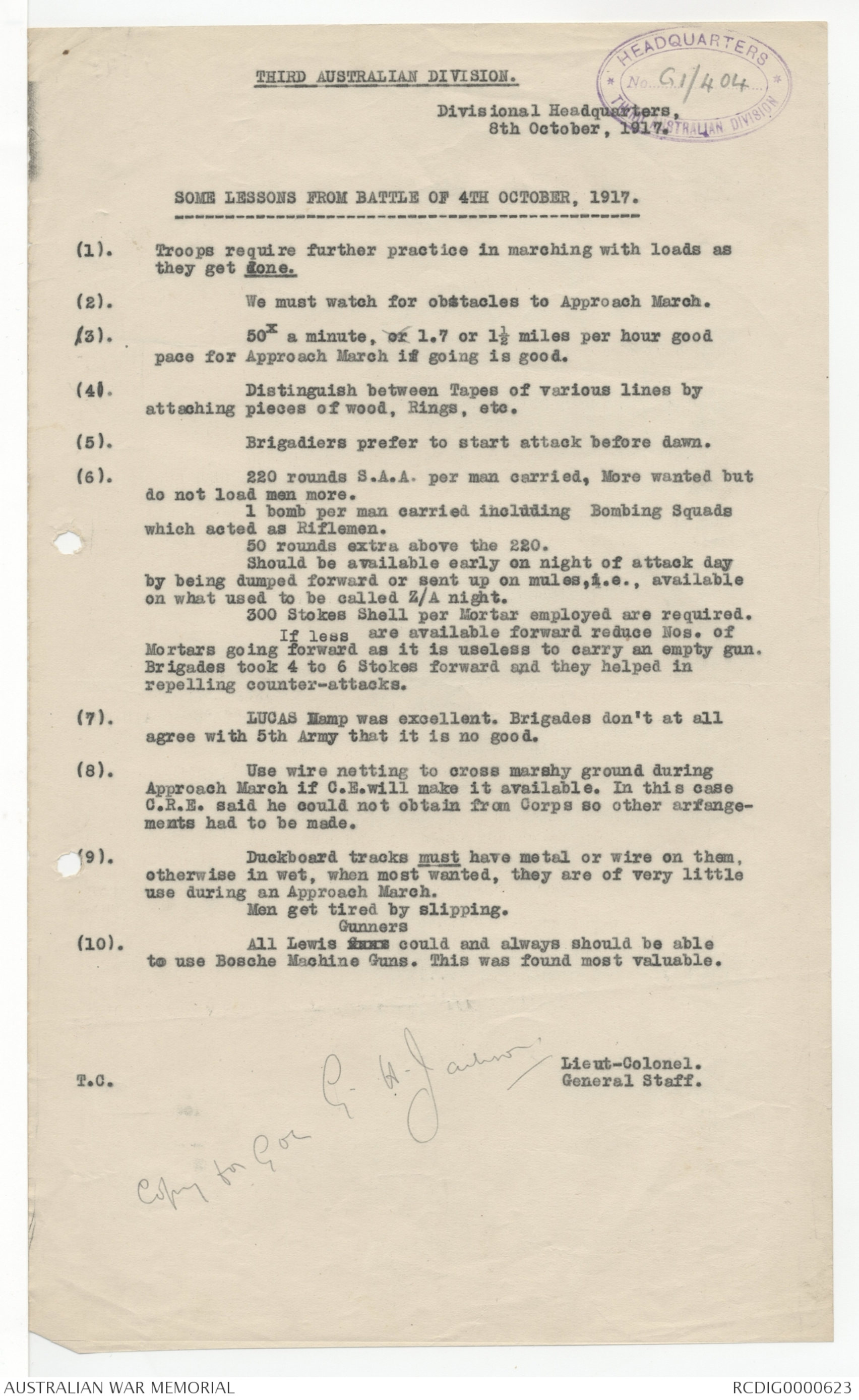
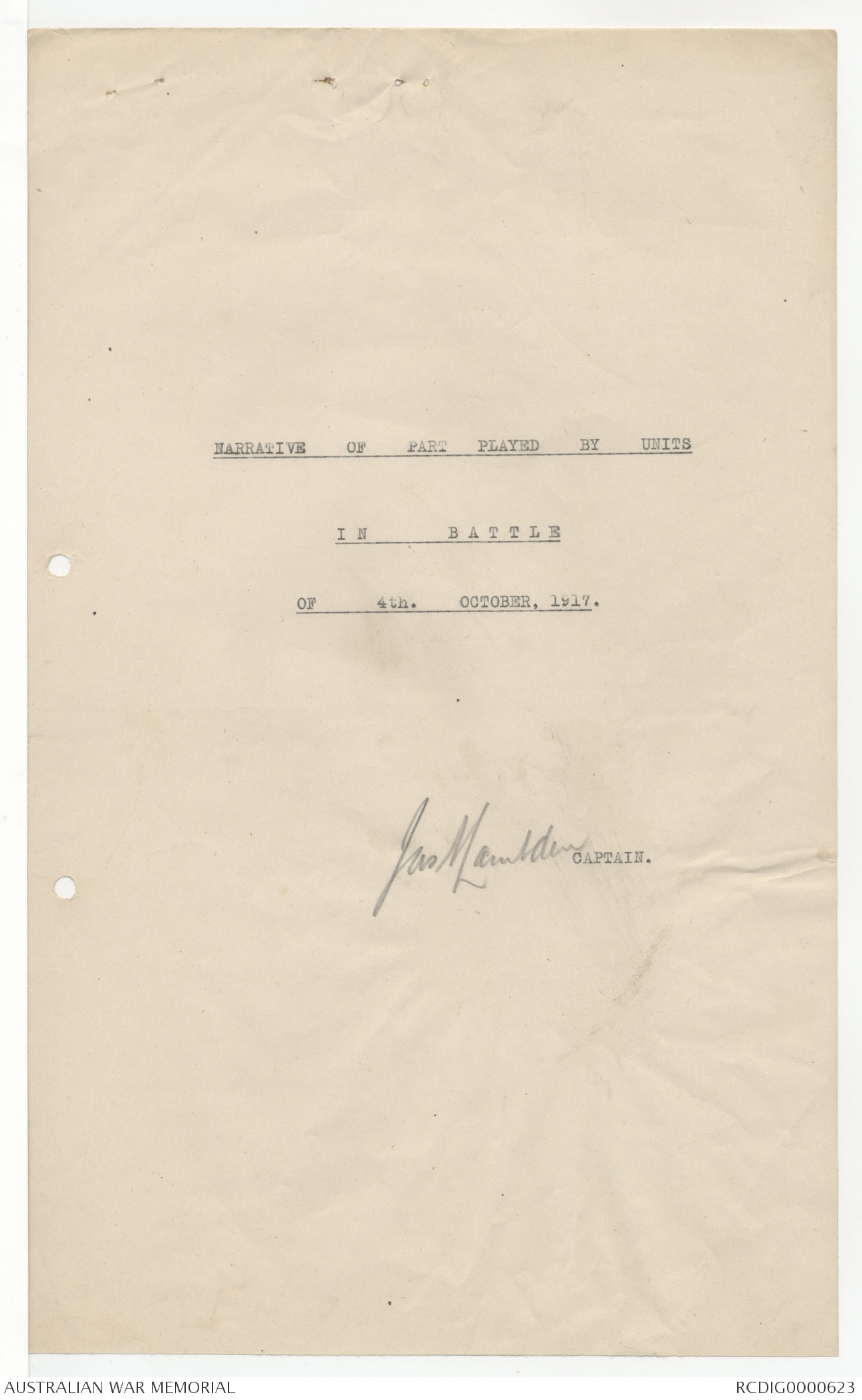
[*GOC.*]
SECRET
SECOND ARMY SUMMARY OF OPERATIONS DURING PERIOD
27th SEPTEMBER, 1917, TO 4th OCTOBER, 1917.
On the 27th September successful minor operations took place to complete the capture of
those portions of the final objectives that had not been reached on the 26th September.
The 15th Australian Brigade took Joist Farm (South-East of Polygon Wood) and gave
valuable assistance to the 33rd Division on their right, who, in spite of determined opposition
and heavy shelling, succeeded in completing their advance before the evening.
The 28th and 29th September passed relatively quietly. An interesting incident occurred
on the 28th on the front of the 5th Australian Division, East of Polygon Wood, which well
showed the demoralising effect of our tactics. A hostile party of some 200 of the 19th Reserve
Division came into the line on the night of the 27th-28th. They were caught by our nightly
artillery harassing fire, and then lost their way. Daylight found them wandering about close
to the Australians, who opened on them with rifle and machine gun fire. They suffered many
casualties, and three Officers and 67 other ranks surrendered in batches during the course of
the morning.
By the evening of the 29th, the enemy had largely recovered from the confusion and
disorganisation caused by our operations of the 26th September. His immediate counter-attack
Division (236th Division), which had been thrown in on the 26th-27th September, had failed
and had been withdrawn again in accordance with his known plan of operations.
Sufficient time had elapsed to permit of the organisation of further local operations, and on
the early mornings of the 30th September and 1st October, a series of counter-attacks developed.
These were aimed against our front between the Menin Road and Polygon Wood, and were
carried out by the 19th Reserve Division, which was holding this section of the front.
On the 30th September the enemy was reported concentrating East of Polygon
Wood and movement was seen in Cameron Covert. Our artillery put down two
heavy barrages and no infantry action followed. On both sides of the Menin Road, however,
at least two attacks were launched with Flammenwerfer and considerable artillery support.
Except for the temporary loss of a post just South of the Menin Road, both these attacks
collapsed under our fire.
On the morning of the 1st October a series of powerful attacks developed between the Menin
Road and the North of Polygon Wood. Our posts at Joist Farm and Cameron Copse were driven
in and heavy fighting ensued. The enemy employed nearly all his guns on intensive
bombardments of the forward area throughout the day, our battery areas being relatively
immune.
Except as already stated, all the enemy's attacks were repulsed and his losses from our
artillery and machine gun fire would appear to have been great.
The night of 2nd-3rd October passed quietly except that the enemy put down an extremely
heavy barrage 500 yards behind our lines between Polygon Wood and the Menin Road.
The 2nd October passed quietly; the enemy's artillery was considerably less active. At
daylight on the 3rd, however, further hostile counter-attacks developed. The front threatened
was from the South of Polygon Wood to the South of the Menin Road. Our S.O.S. barrage may
have broken up a portion of the attack as the only advance actually made was on each side of
the Menin Road. Here, covered by the mist, elements of the enemy's infantry reached our
lines and temporarily surrounded a post held by the Rifle Brigade. All our posts, however,
remained intact, and on the greater portion of the front the attack broke down before reaching
our lines.
The long spell of fine weather broke on the evening of the 3rd October, when a heavy gale,
accompanied by light rain showers, broke in from the South-West. There was some intermittent
hostile shell fire during the night of 3rd-4th, but on the whole the assembling of our troops
was not seriously interfered with.
At 6 a.m., 4th October, the attack was launched on a frontage of about 9,700 yards,
extending from Bitter Wood, South of the Tower Hamlets Spur, to North of Gravenstafel,
where the front of the attack was prolonged by the Army on our left by a further 4,300 yards
to the Ypres—Thourout Railway.
The first objective for the attack was the Red Line, viz. :—
Hampshire Farm—Berry Cottages—Northern portion of Gheluvelt Wood—Polderhoek
Chateau—Reutel Village—Romulus Wood—Thames Farm—Van Mieben—Albatross Farm.
The IX. Corps attacked on the right with troops of the following Regiments:—Middlesex,
Somersets, Lincolns, R. Fusiliers, K.R.R.C. and Rifle Brigade, all of 37th Division. The greater
part of the objective was gained under the barrage, but we failed to take Berry Cottages and
Lewis House.
The X. Corps attacked on the right centre with troops of the following Regiments;—
| R. W. Kent | 5th Division. |
| K.O.S.B. | |
| Devons | |
| D.C.L.I. | |
| K.O.Y.L.I. | 21st Division. |
| Queen's | |
| S.Staff's | 7th Division. |
| Devons |
Despite some hostile shelling of the forward area, the troops reached their assembly
positions up to time. Considerable opposition was met with about Polderhoek Chateau and
West of Reutel, but the objective was gained throughout the whole line, and the troops detailed
for the assault on the further objective were able to reach their jumping off positions up to time.
The I. Anzac Corps attacked in the left centre with troops of the 1st and 2nd Australian
Divisions. The enemy were met with in considerable strength, elements of three Divisions being
found formed up ready for an attack on our line which our assault anticipated only by 10 minutes.
Very severe casualties were inflicted on the enemy by our barrage and with the bayonet, and
the enemy’s opposition was quickly overcome. By 8.12 a.m. the whole of the Red Line was
reported to be in our hands.
The II. Anzac Corps attacked on the left with the 3rd Australian Division on the right and
the New Zealand Division on the left. The New Zealand Division was intermittently shelled
throughout the night causing some casualties. The support line of the 3rd Australian Division
was also intermittently shelled and at 5.30 a.m. the enemy opened a barrage on our front line.
Nevertheless our assault was launched punctually to time and by 9.14. a.m. both Divisions had
reported the capture of the whole of the Red Line, and many German prisoners were already
being sent back.
At 8.10 a.m., after a halt of from one to two hours on the Red Line, the assault was
launched on the Blue Line, viz.:-
Reutel—Judge Copse—Joiners Rest—Noordemhoek—Celtic Farm, West edge of Daisy
Wood— Tyne Cottage—Berlin Wood—Kronprinz Farm.
The X. Corps on the Right employed troops of the following Regiments:—
| E. Yorks. |
21st Division. |
| Northumberland Fusrs. | |
| Lincolns | |
| Manchesters |
7th Division. |
| Queens | |
| Gordons | |
| Borders |
The I. Anzac Corps attacked in the Centre, and the II. Anzac Corps attacked on the Left
with Australian and New Zealand troops.
The enemy offered a stubborn resistance, but by 12.20 p.m. the I. Anzac Corps reported the
capture of the whole of their final objective and the II. Anzac Corps reported similarly at
1.15 p.m. The 7th Division, X Corps, reached practically the whole of their final objective and
probably the 21st Division also, but the situation of the right brigade of this Division in Reutel
was at all times somewhat obscure.
During the day the enemy delivered no less than 10 counter-attacks.
Five counter-attacks were made against the right brigade of the 5th Division between the
Menin Road and Polderhoek Chateau and two attacks against the left brigade of the
21st Division on the Judge Copse Spur North of Reutel. These attacks appear to have
been successfully repulsed. A further attack, however, succeeded in dislodging us from
Judge Copse, Reutel, and Polderhoek Chateau, and at the end of the day our line ran along
the western and northern edges of Polderhoek Chateau Wood, the eastern edge of Cameron
Covert, on the western outskirts of Reutel, through J 11 central to the Broodseinde-
Becelaere Road at point J 6 c 1.0.
Further North, a concentration of the enemy's infantry in D 30 a during the afternoon was
dispersed by our artillery.
At 2.35 p.m. the enemy made a determined attack in three waves from the direction of the
Cemetery in D 17 a, North of Ypres—Roulers Railway, but this attack was broken up by our
artillery, rifle and machine gun fire. A second attack was similarly dealt with, and a
concentration in D 4 b and D 5 a, West of Passchendaele, about noon was broken up by our
artillery before any counter-attack from this direction could materialize. Several S.O.S. signals
were sent up at various points of the front at 7 p.m. and during the night of 4th-5th October,
but the enemy made no further attacks and the consolidation of our line proceeded satisfactorily.
On the greater part of our front the enemy offered a stubborn resistance and the large
proportion of bayonet wounds among the German prisoners testifies to the severity of the hand
to hand confiict which took place on many parts of the front, and in which our troops again
proved their superiority. In places, however, the Germans surrendered freely, an Australian
Officer capturing 31 prisoners single-handed from one blockhouse, and the garrison of another
blockhouse surrendered with three machine guns as soon as our attack was launched.
The enemy Order of Battle on the Second Army front of attack from North to South was
as follows—
10th Ersatz Division, 20th Division, 4th Guard Division, one Regiment of 45th Reserve
Division, one or more Battalions of 16th Division, 19th Reserve Division, 8th Division.
As a result of recent operations it is estimated that seven Battalions of each of the 4th
Guard and 19th Reserve Divisions; six Battalions each of the 10th Ersatz and 20th Divisions;
five Battalions of the 45th Reserve Division; four Battalions of the 8th Division and three
Battalions of the 16th Division have all suffered so heavily as to be of little further fighting
value. The thickening up of the line by the bringing in of Battalions and Regiments of other
Divisions, the confusion of units and the lack of cohesion in the counter-attacks proves how
completely our former attacks have disorganized the enemy and with what haste he has been
compelled to throw in his reinforcements. The enemy situation has not been improved by the
severe losses which he incurred on 4th October.
In spite of very unfavourable weather on the day of attack, our aeroplanes succeeded in
carrying out several contact patrols and flash reconnaissances and in attacking enemy troops
and transport with machine gun fire. One enemy aircraft was brought down by Lewis gun fire
on the l. Anzac Corps front.
Seven field guns, several trench mortars and a large number of machine guns have been
captured.
The total number of prisoners who passed through Corps Cages and Casualty Clearing
Stations from 6 p.m., 3rd October, to 6 p.m., 6th October was 114 officers and 4,044 other ranks.
W. ROBERTSON, Lieut.-Col.,
General Staff, Second Army.
6th October, 1917.
F.S. Co.-1239-400-8-10-17
7/10/17
Corps Conference
Scheme for action of 66th & 49th referred to.
We would have to do it on 12th if They fail
_____
Our deliberate attack on 12th -
On 14th our left (i.e. N.Z.) would swing up
their left to line of Racket Wood
[*MapsCable Wagons& road.*]
Pace of Barrage - 8 min all through
_____
Our adv. H.Q., in case of 4th being
a success, to be Huts.xxx for phase 5 (on 12th) at Menin
[*Hold up 200 of B
teams for
H.Q. work*]
Men to rest at Frezenberg Ridge before
approaching.-
& get cookers up. -
Tents or shelter to be made available
Greatcoats & blankets for troops after assault.
especially as we shall be left in the line. -
Spare troops from 49th & 66th will be left in, to do
fetching & carrying for us. -xxx I prefer to put in my rescue Brigade into
the line
Troops of our Divisions do not go into the line till
the night 10/11. & on night 11/12
Command to pass at 10 a.m. on 11th. -
1600
900
1450
_____
650
_____
800
10th 2400 ]
9th 2600. ]
Conference 7/10/17.1. No time to prepare; refer to orders as we go along.
Coy B.M's not passed
2. Phase 4a
Explain phases & tasks.
Two dispositions
Entraining
Equipment
Tactics
3. Phase 5 - Date
Tasks & dispositions
3 Stages
Barrage rate
Trooping in & times - tents
Coats & blankets.
3A G.I. questions
4. Incompatibilities
5. S.O.S & waste of ammunition, £50000 in 10 min
6. Reorganization
Private papers for Bgdes
8/10/17
Paaschendale Battle
Final Conference.
Divisional Boundaries ✓
Inter- Brigade boundary - altered. √
Corps barrage map ∧ objectives - proposed alteration to red ∧ blue line. √
Barrage time table – [work it out] √ [*X*]
Flanking Brigades. √
| Dispositions - | Right Bgde |
34 (3 Cos & 1 in reserve), 35, 36 - 3 Cos in line, & 1 Co in Res. all Cos on a 2 platoon front.- |
| Left Bgde |
40 (2 Cos in line x 2 platoons), 38 & 1 Co of 39, 37 do. do. 39 - 1 Co for carrying. - 2 Co Bgde Reserve |
| Special Measures for Passchendale- | 10th Bde √ |
| 9th Bde √ | |
| N.Z. " √ |
Passchendale Cellars - sheet. - √
do Photo. - √
General Topography - working around village. √
N.Z. high ground √
Section for 10th Bde. √
Graf Wood - see photo. √
Escort farm √
Visibility for Signallers & Observers. √
Destruction of guns. √ Australian Flag √
Divisional Barrage √
M. G. Barrage - Corps times. √
| Use of M.G's. |
9th - 2 to A,B & C all collected for C Bn & 2 in Reserve. 10th 4 with B. Bn.- & 4 in reserve |
| Use of T.Ms. |
9th same as M.G's 10th 6 guns to B Bn & then forward. - |
Approach march - routes √
Bgde. H.Q. √
Bombardment of Passchendale - Heavies out of barrage. √
Line of Consolidation. √
Position of tape line - marking tapes. - new German tactics (paper) √
Tanks. √
Corps order. √
G.3 Report. √
| Distribution of responsibilities to Staff - | Q. moves &equipment√ | G.I |
| G. Arty, Engineers √ | Artillery to be fully coached. |
Contact Patrols.- √
Zero. | 10th not later than 5.20.- √
8 OCT 1917
Road at
D6
SW of Church
is visible from
Frezenberg
Hill in 20A
Abraham Heights
Hamburg
____________
Not visible for Hill
40
THIRD AUSTRALIAN DIVISION.
S E C R E T.
Divisional Headquarters,
8th October, 1917.
Headquarters,
II A. & N.Z. Army Corps.
With reference to your letter of
to-day forwarding proposed halts for Phase 5 of the Operations. I
submit the following notes:-
1. I have no remarks to make regarding
Tape Line. Position is contingent on the objective being reached
to-morrow.
2. The position of the RED LINE and
its Protective Barrage appears to be satisfactory.
3. With regard to the BLUE LINE and
its Protective Barrage, I strongly desire that the Protective
Barrage should stand in front of my Right Brigade 150 yards East
of the line proposed for it, because 1 wish to retain the opportunity
for my Right Brigade during the halt of this Barrage to work
along the low ground North towards the East of PASSCHENDAELE, if
the situation happens to render such a course necessary.
The line for the Protective Barrage
of the BLUE LINE which would be satisfactory to me would run from
the last "e" in Protective in a straight line to the Railway at
the arranged junction with I ANZAC.
4. I have no remarks to make with
regard to the GREEN LINE and its Protective Barrage.
John Monash
Major-General
Commanding Third Australian Division.
T.C.
[*HEADQUARTERS
No G1/404
THIRD AUSTRALIAN DIVISION*]
THIRD AUSTRALIAN DIVISION.
Divisional Headquarters,
8th October, 1917.
SOME LESSONS FROM BATTLE OF 4TH OCTOBER, 1917.
(1). Troops require further practice in marching with loads as
they get done.
(2). We must watch for obstacles to Approach March.
(3). 50x a minute, or 1.7 or 1½ miles per hour good
pace for Approach March if going is good.
(4). Distinguish between Tapes of various lines by
attaching pieces of wood, Rings, etc.
(5). Brigadiers prefer to start attack before dawn.
(6). 220 rounds S.A.A. per man carried, More wanted but
do not load men more.
1 bomb per man carried including Bombing Squads
which acted as Riflemen.
50 rounds extra above the 220.
Should be available early on night of attack day
by being dumped forward or sent up on mules, i.e., available
on what used to be called Z/A night.
300 Stokes Shell per Mortar employed are required.
If less are available forward reduce Nos. of
Mortars going forward as it is useless to carry an empty gun.
Brigades took 4 to 6 Stokes forward and they helped in
repelling counter-attacks.
(7). LUCAS Camp was excellent. Brigades don't at all
agree with 5th Army that it is no good.
(8). Use wire netting to cross marshy ground during
Approach March if C.E. will make it available. In this case
C.R.E. said he could not obtain from Corps so other arrangements
had to be made.
(9). Duckboard tracks must have metal or wire on them,
otherwise in wet, when most wanted, they are of very little
use during an Approach March.
Men get tired by slipping.
(10). All Lewis Guns ∧ Gunners could and always should be able
to use Bosche Machine Guns. This was found most valuable.
T.C.
[* Copy for GOC *]
G.H. Jackson
Lieut-Colonel.
General Staff.
NARRATIVE OF PART PLAYED BY UNITS
IN BATTLE
OF 4th. OCTOBER, 1917.
Jas A Lambden
CAPTAIN.
 Sam scott
Sam scottThis transcription item is now locked to you for editing. To release the lock either Save your changes or Cancel.
This lock will be automatically released after 60 minutes of inactivity.